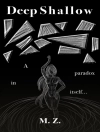The Ebony Frame Edith Nesbit – The Ebony Frame was written in the year 1893 by Edith Nesbit. This book is one of the most popular novels of Edith Nesbit, and has been translated into several other languages around the world.”’Oh! my dear, my dear, how shall I pass the hours till I hold you again?”No thought, then, of my whole life’s completion and consummation being a dream.I staggered up to my room, fell across my bed, and slept heavily and dreamlessly. When I awoke it was high noon. Mildred and her mother were coming to lunch.I remembered, at one o’clock, Mildred coming and her existence.Now indeed the dream began.With a penetrating sense of the futility of any action apart from her, I gave the necessary orders for the reception of my guests. When Mildred and her mother came I received them with cordiality; but my genial phrases all seemed to be someone else’s. My voice sounded like an echo; my heart was not there.Still, the situation was not intolerable, until the hour when afternoon tea was served in the drawing-room. Mildred and mother kept the conversational pot boiling with’
เกี่ยวกับผู้แต่ง
Edith Nesbit (married name Edith Bland; 15 August 1858 4 May 1924) was an English author and poet; she published her books for children under the name of E. Nesbit.She wrote or collaborated on over 60 books of fiction for children, several of which have been adapted for film and television. She was also a political activist and co-founded the Fabian Society, a socialist organisation later connected to the Labour Party.Edith Nesbit was born in Kennington, Surrey, the daughter of agricultural chemist and schoolmaster John Collis Nesbit. The death of her father when she was four and the continuing ill health of her sister meant that Nesbit had a transitory childhood, her family moving across Europe in search of healthy climates only to return to England for financial reasons. Nesbit therefore spent her childhood attaining an education from whatever sources were availablelocal grammars, the occasional boarding school but mainly through reading.At 17 her family finally settled in London and aged 19, Nesbit met Hubert Bland, a political activist and writer. They became lovers and when Nesbit found she was pregnant they became engaged, marrying in April 1880. After this scandalous (for Victorian society) beginning, the marriage would be an unconventional one. Initially, the couple lived separately Nesbit with her family and Bland with his mother and her live-in companion Maggie Doran.Initially, Edith Nesbit books were novels meant for adults, including The Prophet’s Mantle (1885) and The Marden Mystery (1896) about the early days of the socialist movement. Written under the pen name of her third child ‘Fabian Bland’, these books were not successful. Nesbit generated an income for the family by lecturing around the country on socialism and through her journalism (she was editor of the Fabian Society’s journal, Today).In 1899 she had published The Adventures of the Treasure Seekers to great acclaim.












